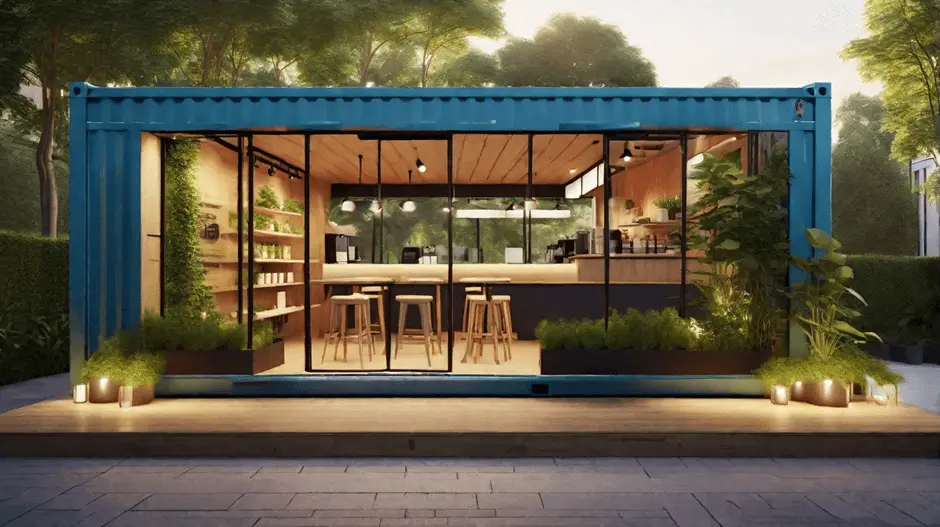Introduction

The use of shipping container homes has been on the rise over the past couple of years making them popular forms of housing. They are often marketed as inexpensive, long-lasting products, which have a positive impact on the environment. However, like every trending topic, there is an equal measure of fact and fiction. To help clarify, this article takes a closer look at the myths and facts that surround shipping container homes.
What is the Concept of Shipping Container Homes?
Shipping container homes are structures made from containers used in the transportation of goods. These containers are then reused and adjusted to act as the foundation for a house. People appreciate them for their sleek and minimalist design and build, as well as the practice of reusing materials. They can be utilized independently or multiple ones can be connected to one another to make vast dwelling areas. These are things such as window and door opening, insulation, services, and installations. The idea has the potential to provide more efficient and cheaper means to construct housing. But the real situation is far from being limited by such factors and can take into account the existence of numerous factors defining their feasibility and inhabiting potential.
If you are thinking of constructing a house using old containers, there are various myths you are likely to come across or believe in.
Myth 1: Building houses from containers is cost-effective.
One that people often hear is that shipping container homes are much more affordable when compared to normal homes. Although it is correct that an ordinary box can be procured at a few thousand US Dollars, the expenses keep piling. Repairs, upgrading, installing insulation, wiring, and rendering compliance with the building codes may add costs greatly. At times, the total cost can be as high as or even more compared to the cost of adopting conventional methods of housing. Also significant are land prices, costs related to the construction of the foundation, and final improvements. Therefore, despite this notion that container homes are cheap, they are actually relatively expensive than people often realize.
Myth 2: Container homes are not durable.
The next myth is that container homes are less durable than traditional houses, which is not true. In fact, shipping containers are intended for use in marine environments so they are built to be tough. They are constructed from corten steel, which is a strong material that also has a high degree of resistance to corrosion. Container homes, if well maintained and altered with some architectural adjustments, can be very long-lasting. However other problem areas like rusting and structural changes have to be dealt with a lot of precautions. However, employing quality materials and efficient construction methods can ensure that these homes are durable. Therefore, despite the obstacles, one can build and design container homes that will last.
Myth 3: Container Homes Are Environmentally Friendly by Nature
A large number of people believe that shipping container homes are intrinsically green by their very nature. This myth originates from the concept of reusing these containers and minimizing construction debris. Nevertheless, the process of turning a container into a living space is quite costly. It is evident that insulation, heating, cooling, and modifications can all have an effect on the environment. Applying toxic chemicals to the containers used in the treatment can also offset some of the environmental advantages. Thus while container homes are part of an acceptable lifestyle, they are in no way environmentally friendly. The construction process has to adhere to sustainable practices and construction materials that are eco-friendly.
The Reality of Living in a Shipping Container Home
Cost Considerations
There are several other expenses associated with living in a home made out of a shipping container after buying one. It is costly to renovate a container to residential standards. It focuses on such aspects as cutting and reinforcing the structure, applying insulation, and connecting utilities. Also, there is a cost incurred in meeting local construction standards and requirements. Costs are incurred in the purchase of land, and construction of a foundation, among others. Hence, even though the idea may sound cost-effective, the overall costs are on par with the conventional houses. This means that the planning should be realistic as far as costs are concerned, and the people involved should be aware of all the expenses.
Durability and Maintenance
Shipping container homes are constructed from sturdy building materials that have been designed to sustain harsh environments. Corten steel used in containers for instance is very sturdy and can also withstand the forces of nature. However, to ensure that they stay as strong as they are made, care must be taken as well as maintenance. It is crucial to incorporate routine checkups on rust and corrosion, particularly at spots where metal is chopped. Incorporating of superior quality, non-corrosive materials for modifications can increase the longevity of these parts. Besides, insulation and ventilation play critical roles in controlling dampness and minimizing the risk of contraction. Therefore, it can be seen that if proper care is taken towards shipping container homes, these are structures that can last long.
Environmental Impact
The relevance of ecological concerns in relation to shipping container homes cannot be viewed as black and white. The opportunity to reuse the containers can decrease the amount of waste, but the changes that are made to them can have some environmental impacts. Products such as insulations should be efficient while at the same time being eco-friendly. Heating and cooling system design is very important and using non-toxic material is also important. It is also necessary to ensure proper treatment and disposal of the hazardous substances that might have been used in the containers. Therefore, all the processes of constructing and maintaining the infrastructure have to be as sustainable as possible to have a positive impact on the environment. This indicates that indeed secondhand shipping container homes have benefits but their green aspect has to be approached with a lot of caution.
Advantages and Disadvantages of Living in a Converted Shipping Container:
In this article, the benefits and drawbacks of shipping container homes will be described. On the positive side, they have a taste that is appealing and can be described as contemporary. They can be easy and fast to build and can be easily adapted to suit the owner’s or designer’s preference. They are somewhat strong and more durable which is an added advantage mainly in regions that experience extreme weather conditions. However, it’s not all good news – there are some drawbacks too. It can be expensive to make modifications, and, at the same time, it can be difficult to properly insulate. Compliance with local regulations regarding construction and acquiring requisite permits may also be challenging. Furthermore, container homes cannot be erected in every region, especially where planning restrictions exist. Hence, as we have seen, they are not without their potential problems.
Conclusion
Shipped container homes can be divided into one of the most captivating and promising types of housing. These are one-off designs and a way to approach the idea of recycling in a new manner. However, they are subjected to myths that require a sense of self-organization with a view to demystifying them. In light of these, anyone who would want to consider this option should ensure that they understand the actual costs, the lifespan of these tours, and the overall impact on the environment. Thus, considering the advantages and disadvantages, potential owners will be able to decide whether possessing the shipping container homes is worth it.
